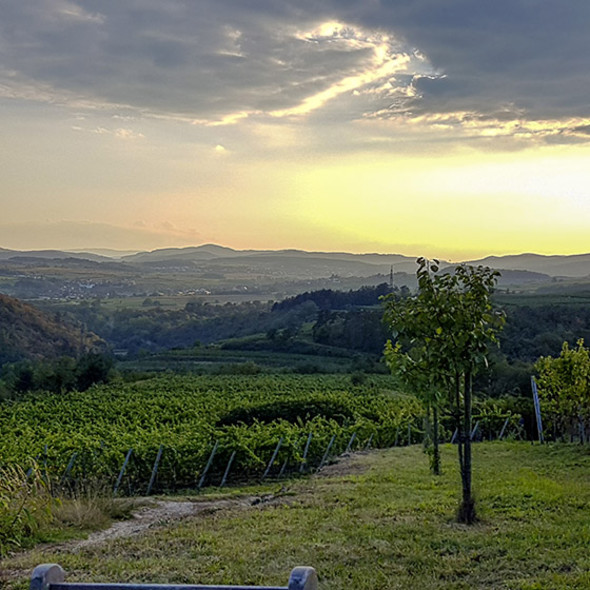How do 16-million-year-old silty marine deposits end up on top of an Austrian vineyard? Isn’t Austria a landlocked country? Well, these are
deposits from an inland sea that dried up, with its residual parts forming the Caspian, Aral and Black Seas
explains Willi Bründlmayer.
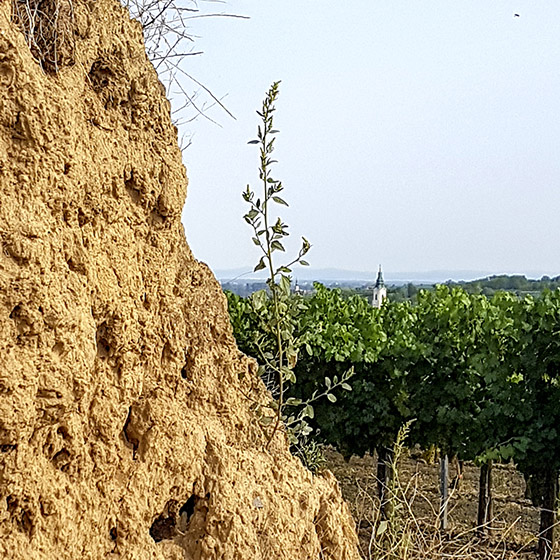
Loess by Sue Tolson
Later this land was thrust up to form the Käferberg, one of the historic vineyards near Langenlois in the Kamptal.
Such vineyards yield deep, spicy and profound Grüner Veltliner, one of the two cornerstone varieties in the Kamptal DAC, the other being Riesling. Naturally, they also grow other varieties here due to climate change, such as the Pinot Noir he points out as we stroll, which cannot be marketed as Kamptal DAC, rather as Niederösterreich, as it is not one of the permitted varieties for the DAC. The wind also plays a role in the soil structure, depositing more loess on the eastern, leeward sides of the hills and stripping it from the western slopes, exposing the underlying hard crystalline rock.
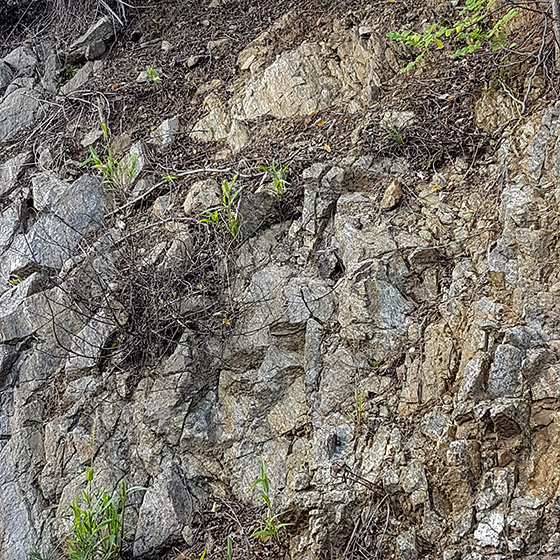
Rocky outcrop by Sue Tolson
Willi also points out the lyre training system and mentions that Bordeaux University had done a comparison of all training systems in the seventies and that the lyre had come out top, with its mixture of half shade, half exposure enabling both protection and early maturity.
Finally, when the other carloads of people fail to materialise, some frantic telephoning reveals that we had been directed to the wrong place, and we should be further down the hill in the Schenkenbichl. We walk down the hill, listening intently for signs of the larger group and finally find them stretched out along a long, exposed outcrop of crystalline rock, hemmed in by the vineyard on the other side. At the end of the row of people I can see the Frau Dr Geologist speaking, gesticulating and cracking at the hillside with her hammer, but fail to hear any of what she is saying. She’s waving a brightly coloured handout, presumably with details of the local geology, which is also clutched by some of the group, but I also fail to obtain one of these, as they have run out.
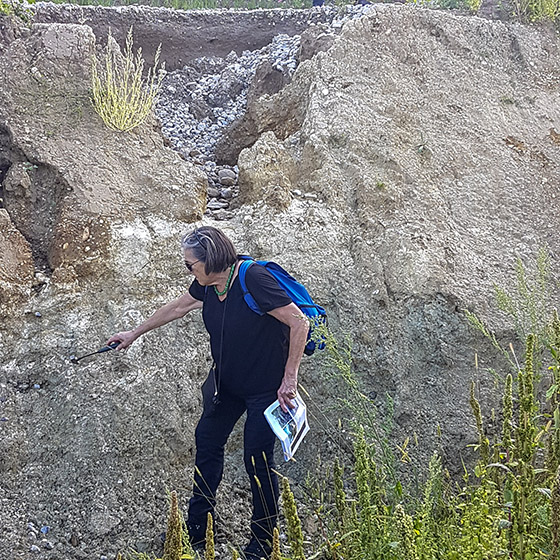
Geologist at work by Sue Tolson
We set off on a tour of the vineyards with some of the Kamptal winemakers, observing at various points the huge variety of soils and level of coverage over the vineyards. Here a wall of loess, blown by the wind, there a ridge of exposed rock. Heading into a rather sodden field next to the vineyards, it had rained heavily over the last few days and growers had needed to call a halt to their early harvest following the hot summer, the Frau Dr hacks at the wall of loess and gravel with her pick, exposing different levels of gravel. Some have a high iron content, now oxidising and turning red, some are highly calcareous and some high in calcium carbonate. She explains the complexities of the chemostratigraphy, apparently the study of the chemical variations within sedimentary sequences to determine stratigraphic relationships, much of which I’m afraid was lost on this rather reluctant scientist.
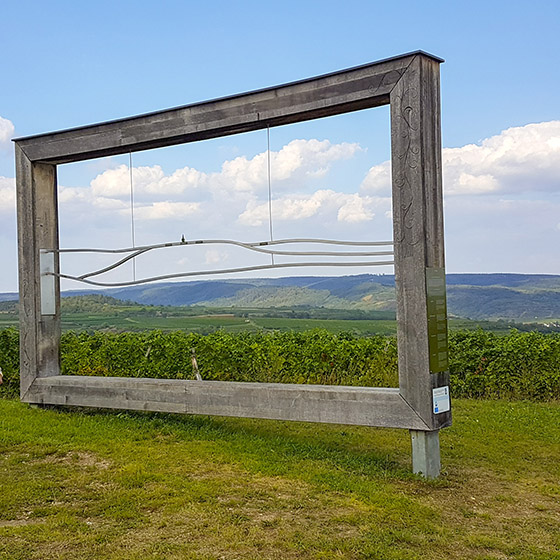
Vineyards framed by Sue Tolson
However, seeing the huge variety of soils within this relatively short distance helps you understand why the wines from these vineyards differ so greatly and why the local winemakers are so keen to classify their vineyards and construct an official quality classification system. Grüner Veltliner needs more water and nutritional supply so is happiest on loess, whereas Riesling needs dry conditions and thrives on rocky, poor soils, preferably higher up. Wines from loess-dominated vineyards will be more fruit-forward and opulent, those from rockier environs more linear and austere. The Kamptal offers a patchwork of such geological characteristics.
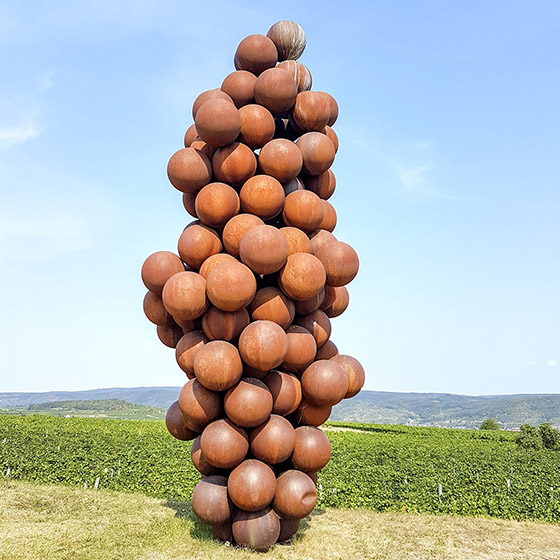
Vineyard art by Sue Tolson
On our walk around the vineyards, we also encountered some surprising things: a huge frame, turning the vineyards into a picture; an enormous bunch of grapes on top of the Käferberg, which had been “silver in colour when initially installed”, explained Willi, “but gradually gained streaks of rust, finally turning a rusty orange, and will probably corrode totally in the end and melt into the soil, becoming part of the vineyard”; a strange grub-shaped creature protruding from the side of the hill, or was it something you might find in the loo or part of a male’s anatomy – opinions were divided; and some hammocks amongst the vines. These ‘objects’ can be found along the Weinweg Langenlois, which leads you through the vineyards of Dechant, Käferberg, Steinhaus and Schenkenbichl, and down into the picturesque, traditional wine town of Langenlois.
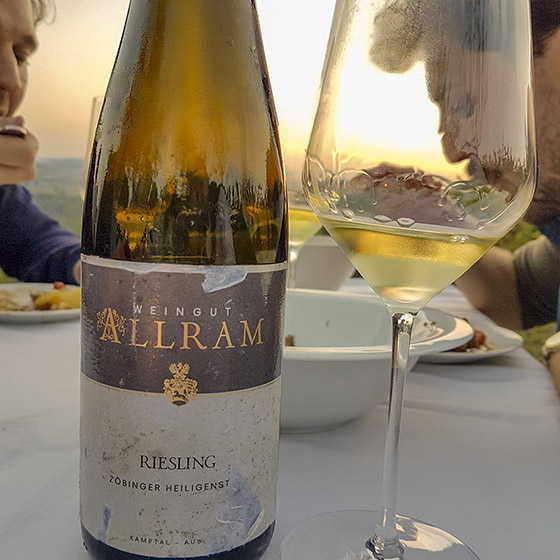
An older vintage of Heiligenstein by Sue Tolson
Our tour ended on the viewing platform near the monster grapes with a view over the historic, pure rock vineyard Heiligenstein, sipping some of the creations of the region’s burgeoning sparkling scene. Then we headed back to the cars to transfer to one of Fred Loimer’s vineyards on the Loiserberg where an immaculately decked table awaited us and we ended the day as the pickers would do, although perhaps with a less elegantly laid table, with a simple meal of boiled potatoes, butter and salt, followed by a warming beef stew with mustard seeds and verjus. We were served a glass of Sturm, fermenting must, and warned not to drink too much as we might end up spending the evening in the portaloo! We ate, drank - wine rather than more Sturm - and chatted as the sun slipped down behind the rolling vineyards and a blazing fire crackled until we headed back to Grafenegg Cottages to rest for another day’s Silent Tasting.
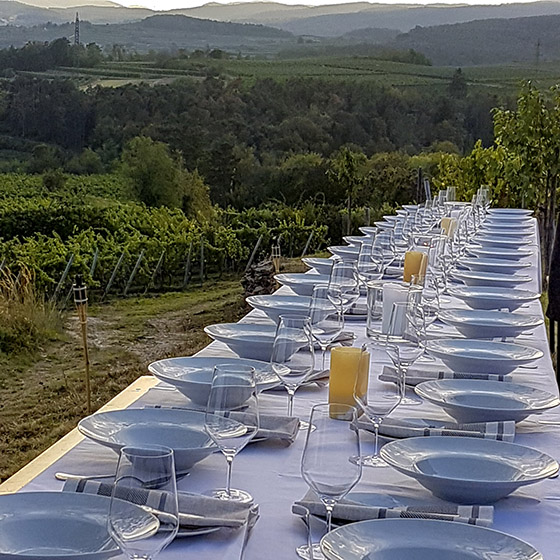
Dining al fresco in Loiserberg by Sue Tolson
Many thanks to ÖTW and Wine&Partners who organised the events and whose guest I was.



